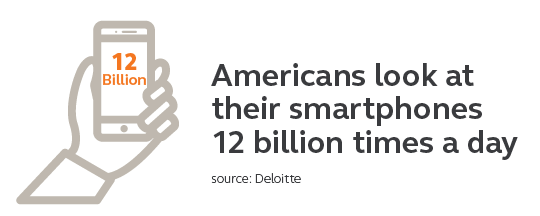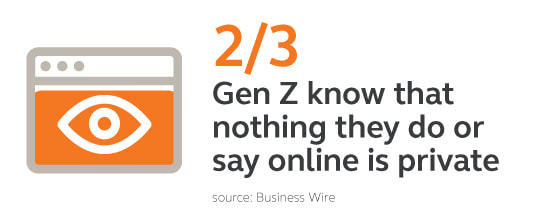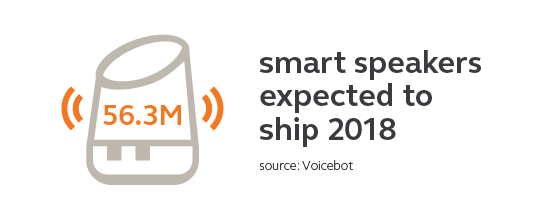Our country is divided, and not just by politics—by technology. On one side of the aisle, there are people who walk, work and even sleep with their smartphones in hand, ready to order the latest gadget as soon as it’s available. And on the other side, there are those who think we were all better off before the iPhone was a glimmer in Steve Jobs’ eye.
Regardless of where you fall on this spectrum, silence is hard to come by these days. Even in our quietest moments, the devices in our hands are filled with people who want to ask us questions, show us cat videos and comment on our every move. The smartphone’s siren song can be nearly impossible to ignore, not to mention the convenience of ridesharing, 24/7 food delivery and being able to order groceries directly from your refrigerator. But how far is too far? If people are finally saying enough, how will that affect branding and design?
First, the bad news
We are woefully unprepared for some of the technological advancements on the horizon. But we’re also not really adapted to a lot of the technology that most of us use every single day. 264 million Americans use a smartphone and, collectively, we look at them about 12 billion times a day.
If that number alone doesn’t give you pause, research shows that the virtual places where many of us spend our hours are bad for mental and emotional well-being—the latest studies show that the more social networks a young adult uses, the more likely he or she is to report depression and anxiety.
Privacy online, or lack thereof, is getting more attention as it becomes painfully clear that our “smart” technology isn’t too clever when it comes to protecting our identities. Between last year’s massive Equifax and wireless hacks, and the news that even your vacuum cleaner is out to get you, technophobes have had a few things to crow about in the last 12 months.

Now, the trends
So far, these very real concerns aren’t translating into consumers buying fewer devices. But people are changing their expectations of how transparent tech companies should be. Time will tell if this kind of technology receives more scrutiny from regulators, but regardless, look for some big changes in personal consumer tech.
The Kids Are Woke
The youngest tech users, Gen Z (today’s teenagers), don’t think of themselves as addicted to technology because it’s a core part of their existence. They also know that the power of the internet can be harnessed for good or evil. 2/3 of Gen Z know that nothing they do or say online is private, but they also prioritize personal privacy. Even though 63% say that living without a smartphone would be extremely difficult, 58% say they’re looking for “relief” from social media. Barring some kind of disaster, don’t expect younger generations to give up personal technology entirely, but they are showing signs of changing their behavior and even quitting social media entirely.

Alexa? Are you spying on me?
In-home automation has been one of the hottest trends of the last few years and 56.3 million smart speakers are expected to ship this year alone. That’s despite the fact that 40% of respondents to a recent survey say that they are concerned about these devices tracking their usage. Even more people said they were worried about the devices revealing information about their daily lives, but that doesn’t seem to be slowing down sales. A full 57% of smart speaker owners have ordered something through their device and 65% say they wouldn’t want to go back to life without it. Suffice it to say this trend isn’t going anywhere if retailers have their way.

Driverless Cars
Everyone is talking about autonomous vehicles. We’ll need to see major shifts in attitudes, transportation infrastructure and urban planning before they’re widely adopted. We’ll have to sort through laws, insurance policies and even ethical dilemmas before AVs come to the general market, but automated vehicles will be coming to a city near you, for better or worse. Then it’s only a matter of time before marketers figure out how to fill ride time with targeted advertising based on your personal data footprint.
Lots of Bots
Do you like talking to actual human beings? Turns out, a lot of people under 35 do not. Fast food restaurants have already cottoned on to the fact that the largest generation in history would rather not make eye contact when ordering from the dollar menu or use a phone for verbal conversation. Expect to see automation taken to the next level on everything from guest requests in hotels and apartments to robots taking over all kinds of jobs from warehouse staff to office tasks. For those of us who aren’t replaced by robots, we’ll need to get used to working alongside them sooner rather than later.
Virtual Reality-Reality Barrier
Most of us can tell the difference between real life and video games, but that line is getting a whole lot blurrier as tech allows us to see, hear, smell, taste and feel situations that aren’t really happening. With the onslaught of “fake news,” we know we already have a problem with people being unable to tell fantasy from reality, so I’ll leave you to create your own dystopian scenarios for what this kind of technology could do in the wrong hands.
There’s Always a Backlash
Human beings are unique in our ability to change social trajectories if something isn’t working. We’re gorging on technology now, but there are some strong signals that the pendulum is swinging back in the other direction. If consumers start taking a more measured approach to personal technology, brands may need to rethink their digital strategies.
Digital Detox
Digital detoxes are one of the next big waves for the health and wellness industry. More and more people of every generation are saying goodbye to social media for certain hours, or even days and weeks at a time, and some are even competing with each other to see who can go the longest without checking their phones. Generation Alpha, kids in grade school or younger, are already swimming in the concept of “limited screen time” because of their Millennial and Gen X parents. Without the constant stream of eyeballs and a captive audience fueled by smartphone addiction, companies will need to become more intentional, and maybe even go back to “old school” marketing and advertising tactics to get noticed.

Cutting the Cord
There are more than 22 million cord cutters in the U.S. and the trend is growing. As of right now, viewership of traditional television is declining each year and digital streaming continues to grow (in fact, 90% of Millennials and Gen Z binge-watch shows). That’s a major shift in how people consume television and media and the cable companies have not caught up. Cord cutters aren’t giving up technology, but they are using it in a more intentional way and avoiding advertising as much as possible.
Going Old School
Since fewer people are willingly sitting through ad breaks, companies are going back to basics. More brands are turning to long-form video, directed by Oscar winners no less, to give customers the kind of content they’re looking for. It’s not a hard sell; it’s brand storytelling on an epic scale. We’ll likely see more of it on more channels, along with more film festivals dedicated to this kind of content.
It’s a new frontier for brands and marketers. Trying to juggle all the latest platforms and technology, not to mention attracting the substantial share of the market who just wants to switch off, is no easy feat. But the most important elements of branding and marketing still apply—have a voice, have a purpose, know your goals and measure everything. And that goes whether your medium is radio, video or an interactive, Alexa-powered ad within the shared driverless car network.




